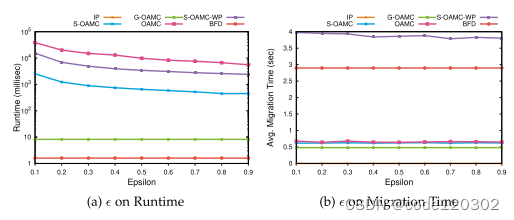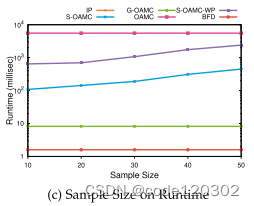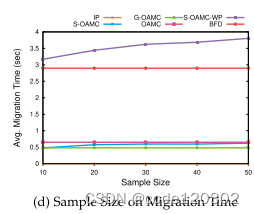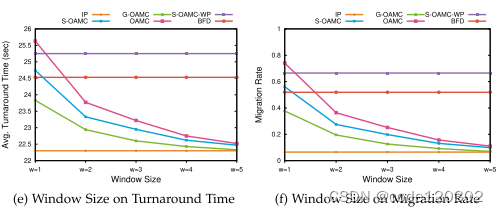《Mobility-Aware Computation Offloading in Edge Computing Using Machine Learning》 论文阅读笔记二
前言
在上一篇博客中罗列并阐述了文章的主要算法S-OAMC和G-OAMC,在结尾处对两个算法进行了比较,体现了两者的异同,这一篇则介绍实验的结果和评价分析。
Experimental Evaluation
提出本文的两种算法后,通过与其他算法进行比较,体现本文算法的一些特点。
Experimental Setup
对比试验
- IP:使用IBM ILOG Concert Technology API for C++ 求解整数规划问题(不一定任何情况都有最优解),作为benchmark。
- Best Fit Decreasing(BFD):降序最优适应,一种常见的启发式算法,按照资源需求降序排列,当cloudlet可用时,将app卸载到最近的cloudlet上。
- Online Assignment of Mobile applications to Cloudlets (OAMC):S-OAMC的最早版本,但是没有使用基于采样的近似方法,也没有采用矩阵补全作为预测方法。
- Sampling-based Online Assignment of Mobile applications to Cloudlets Without using Prediction (S-OAMC-WP):不进行预测的S-OAMC。
- Sampling-based Online Assignment of Mobile applications to Cloudlets (S-OAMC)
- Greedy Online Assignment of Mobile applications to Cloudlets (G-OAMC)
数据来源
- 用户位置(x,y):使用DACT(driving)、TheDisney World (Orlando) traces(walking & riding)、The New York City traces(riding & walking)数据集
- app处理速度p/计算需求w:使用Microsoft Azure VM workload建模
- app带宽需求b/元数据量md:4G网络中的带宽
- app的中间数据量id:使用GWA-T-12 trace的存储使用量标记
- cloudlet位置(x,y):采用均匀分布的方式获得
- cloudlet的总处理速度p/总带宽b:U(1,20)台VM,每台处理速度为U(25000,50000)MHz,带宽为U(5000, 10000)Mbps。
实验场景
考虑5个实验场景。
γ
\gamma
γ 和
θ
\theta
θ的值分别为0.3和3*108。设置
ϵ
\epsilon
ϵ为0.9,
η
\eta
η为10。

Comparative Analysis
分析指标有六个:
turnaround time, offloading time, migration time, migration rate, runtime, mobility patterns。
- Comparative Analysis on Turnaround Time
OAMC、S-OAMC、G-OAMC比BFD、S-OAMC-WP的效果好原因:采用了移动轨迹预测

- Comparative Analysis on Offloading Time and Computation
Time
效果都差不多的原因:offloading time由传播时延和传输时延组成,即与id, b, θ \theta θ,fd有关,这些是app本身的特征,与方法无关。同样地,computation time与w,p有关,是app本身的特征。

虽然这两者与算法无关,但分配策略是不同的。表现在资源利用率上,G-OAMC的贪心策略导致app尽可能分配在cloudlet上,从而使得active cloudlet rate是最低的;而OAMC由于未使用采样的方法,从而使得大部分的cloudlet处于active状态。由于OAMC, S-OAMC, S-OAMC-WP都采用了动态规划,其资源利用率相似,细微差别在于是否使用的采样和预测方法。

- Comparative Analysis on Migration Time
G-OAMC和S-OAMC的结果相近,都比较好。G-OAMC尽可能将app分配到同一个cloudlet上,减少了迁移的数量。S-OAMC使用采样方法根据代价值对app进行排序,选择出合适的app进行迁移,比未使用采样方法的OAMC更有优势,效果也更好。
S-OAMC-WP效果最差,因为没有使用预测的方法,在当前时刻才会决定如何迁移,造成了较高迁移时间。次差是BFD,同样没有提前预测未来特征,但是由于其贪心的策略,每次选择卸载到最近的cloudlet上,所以迁移时间要比S-OAMC-WP低一些。

- Comparative Analysis on Migration Rate
与migration time的走势相同。

- Comparative Analysis on Runtime
rumtime评估时间算法的时间复杂度和可扩展性。
BFD的runtime最短,接下来是G-OAMC,基于贪心能够快速收敛。S-OAMC获得了多项式的运行时间,比OAMC低了一个数量级,因为使用了采样方法;S-OAMC-WP的运行时间比S-OAMC的长,因为没有使用预测方法,必须在每个时隙去得到分配策略。

- Comparative Analysis on Mobility Patterns
评估算法在不同数据集上的迁移率表现,体现算法的可扩展性。G-OAMC和S-OAMC在不同数据集上表现均良好。

Percision Analysis
使用矩阵补全方法进行预测时,首先使用20个app的特征值作为训练集进行训练,然后使用已有特征去预测未来特征。改变已知特征的个数,查看预测的错误率。

Sensitivity Analysis
分析窗口大小w、采样数 η \eta η、 ϵ \epsilon ϵ对结果的影响。
-
ϵ
\epsilon
ϵ定义了结果准确性和取整大小,用于DP-APC中。
ϵ \epsilon ϵ越大,runtime越小,对migration time没有太大影响。
This is due to the fact that as increases, the value of increases in DP-APC, leading to a decrease in the maximum rounded value (r*) and, consequently, reducing the size of the dynamic programming array A. Therefore, the runtime decreases for all DP-based approaches (S-OAMC, OAMC, and S-OAMC-WP).

-
η
\eta
η定义了采样数,用于DP-APC中。
η \eta η越小,runtime越小,对migration time没有太大影响。
By increasing the sample size, the size of the dynamic programming array A becomes larger in DP-APC. This leads to an increase in runtime of these approaches.


- w定义了窗口大小,用于预测。
w越大,trunaroundtime和migration rate就越小。
Using higher value of w, these approaches have more information about future time slots, and thus, they can make better offloading decisions, which lead to reduced turnaround time; second, the applications require less migration rate using higher value of w.

Conclusion
本文提出S-OAMC和G-OAMC两种算法,使用ML方法进行预测,在数据集上取得了好的效果。未来可考虑保证低turnaround time的基础上,实现energy-aware offoading方法。
参考文献:
【1】E. F. Maleki, L. Mashayekhy and S. M. Nabavinejad, “Mobility-Aware Computation Offloading in Edge Computing Using Machine Learning,” in IEEE Transactions on Mobile Computing, vol. 22, no. 1, pp. 328-340, 1 Jan. 2023, doi: 10.1109/TMC.2021.3085527.
【2】E. F. Maleki and L. Mashayekhy, “Mobility-aware computation offloading in edge computing using prediction,” 2020 IEEE 4th International Conference on Fog and Edge Computing (ICFEC), Melbourne, VIC, Australia, 2020, pp. 69-74, doi: 10.1109/ICFEC50348.2020.00015.
【3】Y. Mao, C. You, J. Zhang, K. Huang and K. B. Letaief, “A Survey on Mobile Edge Computing: The Communication Perspective,” in IEEE Communications Surveys & Tutorials, vol. 19, no. 4, pp. 2322-2358, Fourthquarter 2017, doi: 10.1109/COMST.2017.2745201.
【4】王凌,吴楚格,范文慧.边缘计算资源分配与任务调度优化综述[J].系统仿真学报,2021,33(03):509-520.DOI:10.16182/j.issn1004731x.joss.20-0584.






















 1584
1584

 被折叠的 条评论
为什么被折叠?
被折叠的 条评论
为什么被折叠?








